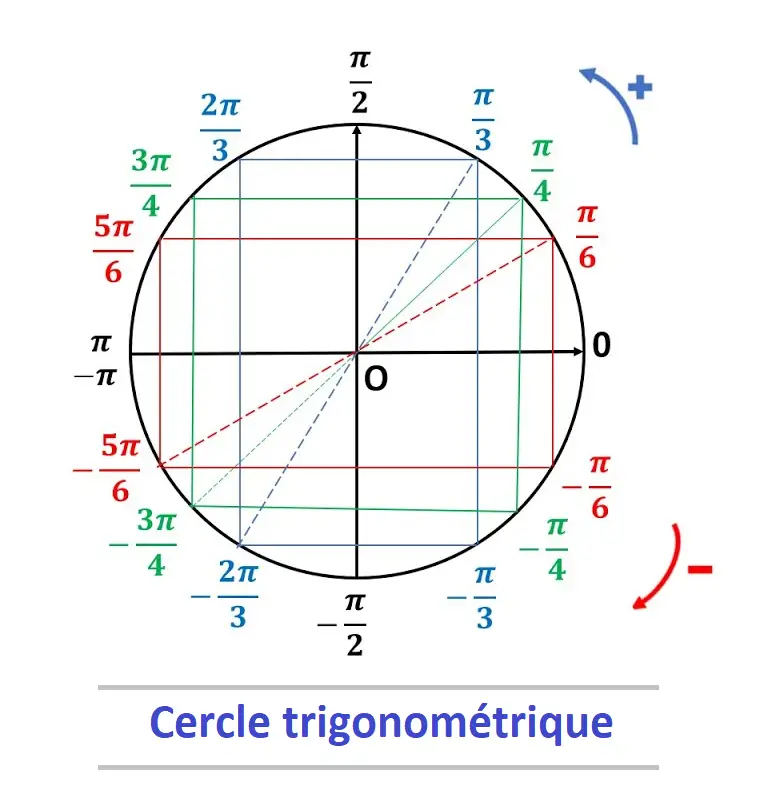Mathématiques
Physique
Chimie
Calculateurs Scientifiques
© The scientific sentence. 2010

| |
|
Articles
Science and sociétés
Équations trigonometriques
Formules trigonométriques
Équations trigonometriques
Exemples
Voici les 3 équations trigonométriques de base:
• Si cos x = b = cos a, alors
x = Arccos(b) = cos-1(b) = a + 2kπ ou
x = - a + 2kπ , k ∈ Z
• Si sin x = b = sin a , alors
x = Arcsin(b) = sin-1(b) = a + 2kπ ou
x = π - a + 2kπ , k ∈ Z
• Si tan x = b = tan a , alors
x = Arctan(b) = tan-1(b) = a + kπ , k ∈ Z
 Équations trigonométriques Équations trigonométriques
Nous utliserons les formules suivantes:
cos(a + b) = cos a cos b - sin a sin b
cos(a - b) = cos a cos b + sin a sin b
Qui donnent:
2 cos a cos b = cos(a + b) + cos(a - b)
2 sin a sin b = cos(a - b) - cos(a + b
cos2a + sin2 a = 1
sin (2a) = 2 sin a cos a
tan(a + b) = (tan a + tan b)/(1 - tan a tan b)
Qui donne :
tan(2a) = 2tan a/(1 - tan2 a)

Exercice 1
Rappelons que :
si a > 0 et b > 0 alors
a < b ⇔ a2 < b2
Exemple:
|cos x + sin x| ≤ √ 2
⇔
|cos x + sin x|2 ≤ 2
cos2 x + sin2 x + 2 six cos x ≤ 2
1 + sin(2x) ≤ 2
sin(2x) ≤ 1
∀ x ∈ R , X = 2x ∈ R sin(X) ≤ 1
∀ x ∈ R , on a toujours sin(x) ≤ 1
Il vient donc :
|cos x + sin x| ≤ √ 2
Exercice 2
a) 2 sin a sin b = cos (a - b) - cos (a + b)
2 sin π/24 sin 11π/24 = cos (π/24 - 11π/25) - cos (π/24 + 11π/24)
cos (10π/24) - cos (12π/24) =
cos (5π/12) - cos (π/2) = cos (5π/12)
2 sin π/24 sin 11π/24 = cos (5π/12)
b) 2 sin 5π/24 sin 7π/24 = cos (5π/24 - 7π/24) - cos (5π/24 + 7π/24)
cos (2π/24) - cos (12π/24) =
cos (π/12) - cos (π/2) = cos (π/12)
2 sin 5π/24 sin 7π/24 = = cos (π/12)
cos (5π/12) cos (π/12) = (1/2)( cos (5π/12 + π/12) +
cos (5π/12 - π/12)) =
(1/2)( cos (6π/12) + cos (4π/12)) =
(1/2)(cos (π/2) + cos (π/3)) = (1/2)( 0 + 1/2) = 1/4
Donc:
2 sin π/24 sin 11π/24 x 2 sin 5π/24 sin 7π/24 = 1/4
16 sin π/24 sin 11π/24 x sin 5π/24 sin 7π/24 = 1
24 sin π/24 sin 11π/24 x sin 5π/24 sin 7π/24 = 1
Exercice 3
1.
a) cos x cos y = (1/2) (cos(x + y) + cos (x - y) )
On pose x = a + b et y = a - b
Donc x + y = 2a et x - y = 2b
cos (a + b) cos (a - b) = (1/2) (cos(2a) + cos (2b))
On applique:
a = x/2 et b = π/6 . Donc:
cos (x/2 + π/6) cos (x/2 - π/6) = (1/2) (cos(2x/2) + cos (2π/6))
= (1/2) (cos(x) + cos (π/3))
(1/2) (cos(x) + 1/2)) = (1/4) (2cos x + 1)
cos (x/2 + π/6) cos (x/2 - π/6) = (1/4) (2cos x + 1)
Donc :
(2cos x + 1)= 4 cos (x/2 + π/6) cos (x/2 - π/6)
b)
cos x + cos 3x = cos x + cos (x + 2x) = cos x + cos x cos 2x - sin x sin 2x
cos x + cos x cos 2x - 2 sin2 x cos x =
cos x + cos x cos 2x - 2 sin2 x cos x
cos x ( 1 + cos 2x - 2 sin2 x)
= cos x ( sin2x + cos2x + cos 2x - 2 sin2 x) =
cos x (cos2x - sin2 x + cos 2x ) =
cos x (cos 2x + cos 2x ) = 2 cos x cos 2x
Donc:
cos x + cos 3x = 2 cos x cos 2x
Il vient donc:
A(x) = cos 2x + 2 cos x cos 2x = cox 2x (1 + 2 cos x)
= cox 2x 4 cos (x/2 + π/6) cos (x/2 - π/6) =
4 cox 2x cos (x/2 + π/6) cos (x/2 - π/6)
A(x) =
4 cox 2x cos (x/2 + π/6) cos (x/2 - π/6)
2. L'équation A(x) = 0 implique :
cox 2x cos (x/2 + π/6) cos (x/2 - π/6) , c'est à dire :
cox 2x = 0 , ou
cos (x/2 + π/6) = 0 , ou
cos (x/2 - π/6) = 0
cox 2x = 0 ⇒ 2x = π/2 + 2 k π ou 2x = - π/2 + 2 k π
x = π/4 + kπ ou - π/4 + kπ , k ∈ Z.
cos (x/2 + π/6) = 0 ⇒ x/2 + π/6 = π/2 + 2 k π ou
x/2 + π/6 = - π/2 + 2 k π
x/2 = π/2 - π/6 + 2 k π = 2π/6 + 2 k π = π/3 + 2 k π
x/2 = - π/2 - π/6 + 2 k π = -4π/6 + 2 k π = -2π/3 + 2 k π
ou
x = 2π/3 + 4 k π ou x = - 2π/3 + 2 k &pi, k ∈ Z.
cos (x/2 - π/6) = 0 ⇒ x/2 - π/6 = π/2 + 2 k π
cos (x/2 - π/6) = 0 ⇒ x/2 - π/6 = - π/2 + 2 k π
x/2 = π/2 + π/6 + 2 k π = 4π/6 + 2 k π = 2π/3 + 2 k π
x/2 = - π/2 + π/6 + 2 k π = -2π/6 + 2 k π = -π/3 + 2 k π
x = 4π/3 + 4 k π ,x = = -π/3 + 2 k π, k ∈ Z.
L'ensemble des solutions est:
S = {- π/4 + kπ, π/4 + kπ , - 2π/3, + 2 k π + 2π/3 + 4 k π ,
4π/3 + 4 k π , - π/3 + 2 k π , k ∈ Z }
Exercice 4
Nous avons la formule suivante :
tan (x + y) = (tan x + tan y)/( 1 - tan x tan y)
D'où, avec x = y :
tan (y + y) = (tan y + tan y)/( 1 - tan y tan y)
ou
tan (2y) = 2 tan y/( 1 - tan2 y)
On pose tan x = 1/7 et tan y = 2
tan (x + 2y) = (tan x + tan 2y)/( 1 - tan x tan 2y) =
(tan x + 2 tan y/( 1 - tan2 y)/
( 1 - tan x (2 tan y/( 1 - tan2 y)) =
(tan x + 2 tan y/( 1 - tan2 y)/
( 1 - 2tan x tan y/( 1 - tan2 y)) =
tan x ( 1 - tan2 y) + 2 tan y/
(1 - tan2 y - 2tan x tan y) =
tan x = 1/7 et tan y = 2
On remplace:
(1/7)(1 - 4) + 4 /
( 1 - 4 - 2 (1/7) (2)) =
= (- 3/7 + 4) /( - 3 - 4/7) = (25/7) / (- 25/7) = - 1
Donc:
tan (x + 2y) = - 1
tan (x + 2y) = - 1 = tan (- π/4)
⇒
x + 2y = - π/4 + kπ k ∈ Z
Nous avons:
k = 0 &rArr, x + 2y = - π/4
k = - 1 &rArr, x + 2y = - π/4 - π = - 5π/4 = 3π/4
k = + 1 &rArr, x + 2y = - π/4 + kπ = 3π/4
k = - 2 &rArr, x + 2y = - π/4 - 2π = - 9π/4 = - π/4
k = + 2 &rArr, x + 2y = - π/4 + 2π = 7 π/4 = - π/4
Conclusion :
Si x + 2y ∈ ]0; π/2[ , alors S = {3π/4 }
-- Abdurrazzak Ajaja
novembre 2023
|
|